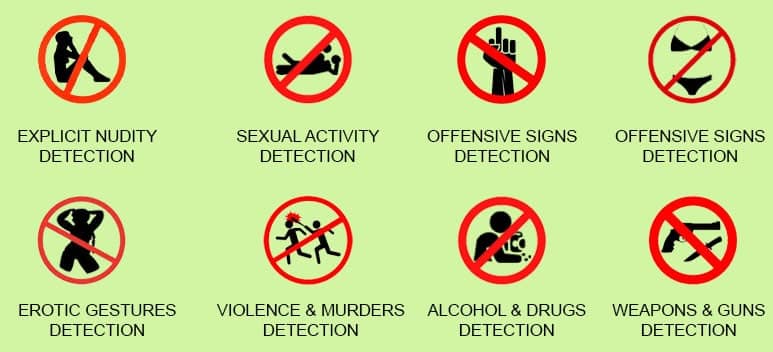To define content moderation, it is paramount to understand why content moderation is even needed. Constitutions worldwide allow people to express their opinions freely, a right known to many as freedom of speech. The growth of social media platforms meant that an individual’s opinion could reach thousands of people at a time. It is not only speech that people can express on social media platforms. People are also constitutionally allowed to express themselves in manners that others may not like in what is known as freedom of expression. With social media around, people show off their lifestyle, daily activities, fantasies, and everything else that people can express via text, image, or video.
The problem arises when people abuse their freedom of speech and expression to post offensive and objectionable content, including hate speech, nudity, and violent images or videos. More than 80% of the content available online is generated by other users, also known as user generated campaigns (UGC), with exclusive content by brands and companies accounting for less than 20% of all online content. With the vast reach of social media, it is essential to control such content to ensure that the abuse of personal rights and the power of social media do not go unabated.
What is content moderation?
The process by which online user generated content in places such as social media and e-commerce sites is filtered and controlled to weed out offensive and objectionable content is user generated content moderation. Content moderation ensures that uploaded content is filtered, screened, and approved before it appears online round the clock to provide a safe online environment. In companies such as Facebook, Twitter, and LinkedIn, a team of people called the social media content moderator work round the clock reviewing and filtering user content, including videos, images, and comments. As per the content moderation definition above, content moderation protects the content available to all users and the company’s brand. No company wants to be associated with objectionable content posted on their site.
How does content moderation work?
Each time a user posts or uploads content online, it passes through the automated AI & ML review algorithms, checking for any pre-identified objectionable content. This is also called content moderation using AI & ML models or automated content moderation techniques. If none is found, then moderated content is allowed online. If anything offensive and objectionable is found, the AI algorithm either removes the content entirely or sends it to the community of human content moderators, where it is either approved or rejected. Content moderation does not stop at this point. Once online, the content is monitored and reviewed thoroughly before making it visible. Suppose other users also flag the content as objectionable. In that case, it is reviewed and pulled down if necessary with a warning or a block of the user account responsible for posting the content.

What is social media content moderation?
Social media content moderation involves monitoring all user-generated content on each social media platform. Different social media platforms employ different types of content moderations. For some platforms, content moderation occurs after uploading, while in others, moderation occurs before content goes live and is visible to other users.
Today social media plays a significant role for brands and users alike. Brands use social media to reach out and interact with their customers. Social media allows users to interact with other fellow consumers and make decisions based on the information they can gather online. The abundance of user and brand-generated content means there is a chance for substandard content that can be harmful to a brand or is found objectionable by the general audience. Some of the various forms of content that require moderation in social media include.
Customer Interactions
As brands interact with their audiences, they generate chats, feedback, and comments on posts and reviews. Not all people share each company’s ethos, vision, or mission. A discontented consumer may express their dislike for the brand or company profane or offensive. Such expressions could damage the brand or go against the community guidelines and platform policies. Such content requires to be detected by platforms.
Online reviews
The age of social media means that an individual can access numerous instant reviews about a product based on the experience of other consumers. Businesses often use social media reviews to build trust and confidence in their brand. Reviews thus form part of the long-term business success strategy. Therefore, reviews are usually scanned and moderated to filter out offensive reviews.
User uploads and posts
Every day, millions of people post their thoughts and comments on other posts and upload pictures and videos online. The amount of such content is staggering. At such a scale of interaction, it is not uncommon for people to differ or disagree, and if left unmonitored, it can spiral into chaos of offensive interactions. Users can also upload offensive images or videos, including pornographic content, gun violence, and drug abuse. Image and video moderation ensures that uploads and interactions against platform policies and user community guidelines are detected and removed before they reach the masses or once other users flag them.

Online contests
Individuals or brands sometimes hold online contests to reward their customers or engage them. However, People can use such games and contests to scam people off their cash or engage in other malicious activities. Malicious online contests need to be detected and removed to keep users safe online.
What are the different content moderation techniques?
There are four main techniques used in content moderation: pre-moderation, post-moderation, reactive moderation, and user-only moderation. Regardless of the moderation techniques employed by any platform, the goal remains to keep their online space clean and safe for all users.
Pre-moderation involves detecting offensive or objectionable content before the content gets online. Post moderation checks the content after it is published online. As such are allowed to upload their content in real-time, but such content is removed if it is detected to violate the platform policies or goes against media community guidelines.
In reactive moderation, content moderation is carried out by the content moderator and users. Users flag abusive, offensive, or any other objectionable content in areas such as the comments section, which is then monitored and cleaned up by the content moderators. In user-only moderation, users have the power to moderate UGC. If several users flag a particular piece of content, it is automatically hidden, also known as human content moderation.
Why is content moderation important for user generated campaigns?
There are numerous reasons and benefits to conducting content moderation. One key reason is to ensure a safe online space for all users. That includes ensuring content such as spam, abusive and harmful information does not reach millions of people, including underage people to whom it could be inappropriate. It also ensures that information that can disrupt public order is detected and taken down swiftly before the damage is done.
For businesses, moderating content is critical to understanding what consumers think about the brand. Also, moderation removes content that most consumers consider a nuisance, such as spam, that can result in customer disappointment and drive them away from the business site or platforms. Businesses invest vast amounts of resources to grow their digital presence. Therefore, they will take any necessary steps to detect and remove any unwarranted content that threatens their investment.
For governments and other institutions of authority, content moderation is a prerequisite to ensuring the safety and security of its citizens. Government agencies need content moderation to detect and filter users with intent to cause security problems, such as people planning and organizing terror activities, robbery, human trafficking, or any form of crime.
How to start the process of content moderation?
Every minute, the volume of content posted globally is vast. It is challenging for social media companies to handle these enormous volumes of content all by themselves, given a company’s human resource constraints. As a result, several content moderation companies have risen to help. This company provides one of the most accurate and reliable content moderation services.
The social networking sites contract the content moderation companies on their behalf for automated content moderation swiftly and effectively. Annotation Labs, with their subject matter professionals carry out the job with content moderator training and using advanced content moderation tools and software. They moderate conversations and track social media activities while analyzing content to detect spam or objectionable content warranting removal. Read more on their other services such as NLP and Sentiment Analysis. As more content gets generated, it will need to be moderated, and there comes the assurance that the content moderation industry will be expanding.





